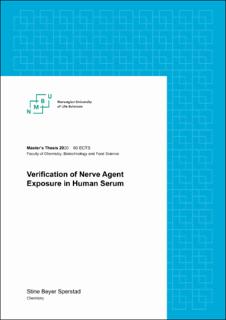| dc.contributor.advisor | Ekeberg, Dag | |
| dc.contributor.advisor | Røen, Bent-Tore | |
| dc.contributor.author | Sperstad, Stine Beyer | |
| dc.coverage.spatial | Norway | en_US |
| dc.date.accessioned | 2020-10-09T14:01:44Z | |
| dc.date.available | 2020-10-09T14:01:44Z | |
| dc.date.issued | 2020 | |
| dc.identifier.uri | https://hdl.handle.net/11250/2682083 | |
| dc.description.abstract | Nerve agents are the most toxic chemical warfare agents known. They have been used at several occasions despite that the Chemical Weapon Convention (CWC) prohibits the production, storage, and use of these chemicals. Nerve agents affect the nervous system after they are absorbed through inhalation or skin exposure. On suspicion of nerve agent exposure, it is vital to get this verified and get the right treatment fast for the exposed persons. The study that is presented in this thesis, deals with the development of a method to determine nerve agent exposure by the analysis of human blood serum. The method is based on three parts; isolation of Butyrylcholinesterase (BuChE), enzymatic digestion of the protein, and analysis of the target peptide by liquid chromatography-tandem mass spectrometry (LC-MS/MS). Magnetic beads coated with antibodies, specific for BuChE, were used for the isolation of BuChE in serum. Enzymatic digestion was evaluated and optimized by examining the denaturation conditions, enzyme, and digestion solution. Analyses of the target peptide were performed on LC-MS with switch technique and trap-column with backflush.
Cross-linking of the antibodies showed a significant increase in the yield of BuChE from human serum. The optimized enzymatic digestion conditions were 0.2 mg/mL pepsin in 2 % formic acid. Pepsination resulted in a nonapeptide FGAS198AASAG with m/z 796.3477, which is suitable for LC-MS analysis. S198 is the binding site for the nerve agents, which makes it the target peptide. The LC conditions were optimized focusing on the timing in the switching technique, column dimensions and the mobile phase composition. The reduction of the inner diameter of the separation column, from 2 mm to 1 mm, resulted in a 10-fold increase in the peak intensity of the BuChE target peptide. The mobile phase delivered by the loading pump was optimized to 2.5 % formic acid and 2.0 % acetonitrile (ACN). In the mobile phase delivered by the analytical pump, 2.5 % formic acid and a gradient from 5-90 % ACN over 10 minutes was used. This resulted in the optimal peak intensity of the BuChE target peptide. The loading time was chosen to be 0.5 min, followed by backflush to the separation column, prior to switch back at 4 minutes for the exclusion of the larger peptide with a longer retention time.
The nerve agent adducts VX-BuChE and GF-BuChE were detected with excellent analytical sensitivity when the human BuChE was fully inhibited. Qualitative validation is vital to confirm if the method is fit for its purposes. The limit of detection was not estimated. Hence, the intensity of the target nonapeptide with fully inhibition of human BuChE indicates that less than 10 % inhibition can be detected. | en_US |
| dc.description.abstract | Nervegasser er de mest toksiske av de kjemiske stridsmidlene som er kjent. De har blitt benyttet i flere anledninger til tross for at den kjemiske våpen konvensjonen (CWC) forbyr produsering, lagring og bruk av disse kjemikaliene. Nervegass reagerer raskt på nervesystemet etter å ha blitt absorbert via luftveier eller ved hudeksponering. Ved mistanke om nervegasseksponering er det viktig å få dette verifisert, og at de eksponerte personene får rask behandling. Studien som er presentert i denne oppgaven, håndterer utviklingen av en metode for bestemmelse av nervegasseksponering ved analyse av blodserum hos mennesker. Metoden tar for seg tre deler; isolering av Butyrylcholinesterase (BuChE), enzymatisk nedbrytning av proteinet og analyse på væskekromatografi-tandem massespektrometer (LC-MS/MS). Magnetiske kuler dekket med antistoff, spesifikt for BuChE, ble benyttet for isolering av BuChE i serum. Enzymatisk nedbrytning ble evaluert og optimalisert ved å undersøke betingelser for denaturering, enzym og løsning for nedbrytningen. Analyse av peptidet ble utført på LC-MS ved bruk av svitsjeteknikk og trap-kolonne med backflush. | en_US |
| dc.description.sponsorship | Forsvarets Forskningsinstitutt | en_US |
| dc.language.iso | eng | en_US |
| dc.publisher | Norwegian University of Life Sciences, Ås | en_US |
| dc.rights | Navngivelse 4.0 Internasjonal | * |
| dc.rights.uri | http://creativecommons.org/licenses/by/4.0/deed.no | * |
| dc.subject | Nerve agents | en_US |
| dc.subject | LC-MS/MS | en_US |
| dc.subject | Immunomagnetic separation | en_US |
| dc.subject | Chemical warfare agents | en_US |
| dc.subject | Butyrylcholinesterase | en_US |
| dc.title | Verification of nerve agent exposure in human serum | en_US |
| dc.type | Master thesis | en_US |
| dc.description.version | submittedVersion | en_US |
| dc.source.pagenumber | 92 | en_US |
| dc.description.localcode | M-KJEMI | en_US |

